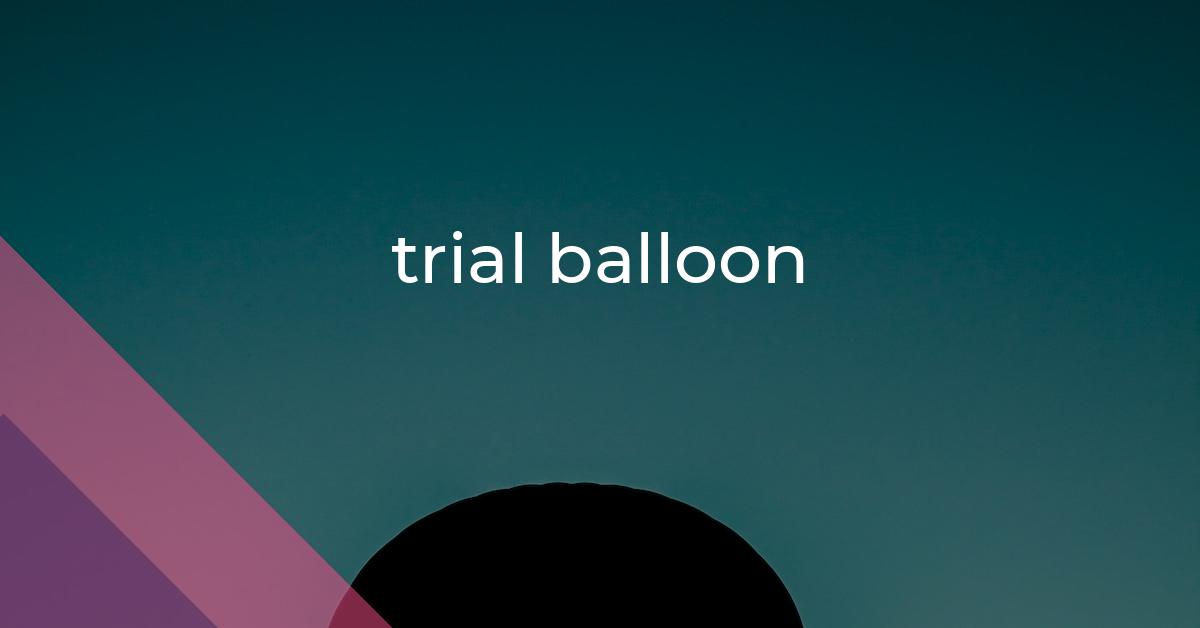trial balloon: Idiom Meaning and Origin
What does ‘trial balloon’ mean?
The idiom "trial balloon" refers to a tactic where an idea or proposal is tested without commitment. It allows the originator to gauge people's reactions before making a final decision.

Idiom Explorer
The idiom "try it on" means to test or experiment with something, typically a theory or idea, to see if it works or is effective.
The idiom "try on for size" means to test or evaluate something to see if it fits or suits one's needs or preferences.
The idiom "trial by media" refers to the phenomenon where a person's guilt or innocence is determined and judged by the media before a legal trial takes place. This can potentially impact public opinion and prejudice the outcome of a fair and impartial trial.
"Trial by fire" means to be tested or judged in a difficult or challenging situation, often used to describe a demanding initiation or a rigorous test of one's abilities or character.
The idiom "throw caution to the wind" means to act without considering the potential risks or consequences.
The idiom "test the waters" means to try something cautiously or to gather information before making a decision or taking action.
The idiom *test bed* refers to a situation or environment where new ideas, technologies, or theories are tested or experimented with. It serves as a platform for evaluating the feasibility or effectiveness of something before implementing it on a larger scale.
The idiom "take a gamble" means to take a risk or chance on something without being certain of the outcome.
The idiom "take a flyer" means to take a risk or gamble without considering the potential consequences or likelihood of success.
This idiom means to begin with a fresh start or a new approach, without any preconceived notions or biases from the past.
Balloon Unveiled
The idiom "trial balloon" has its roots in the realm of aviation and was originally used to test new aircraft designs or equipment. A balloon or kite equipped with these experimental elements would be released into the air to assess their feasibility and performance. Over time, the term "trial balloon" came to be associated with the testing of ideas or proposals in a metaphorical sense.
In political contexts, a trial balloon refers to the intentional release of information or an idea to gauge public opinion or test its potential acceptance before fully committing to it. Politicians, government officials, or public figures often use this strategy to assess the reaction from the public or stakeholders without fully committing themselves to a specific course of action.
The purpose of a trial balloon is to assess the viability or popularity of an idea before formally announcing or implementing it. If the initial response is positive, the idea may be pursued further. If the reaction is negative, it allows the originator to retreat without significant consequences or public embarrassment.
Using a trial balloon can be a strategic tool, providing valuable insights into public sentiment, potential challenges, or roadblocks before making a final decision. It allows decision-makers to gauge public opinion, anticipate potential resistance, or identify areas that might need addressing before moving forward.
The idiom "trial balloon" captures the notion of testing the waters or exploring options before committing fully to a particular plan of action. It suggests a sense of uncertainty and experimentation, highlighting the need to gather information and feedback before making a final decision. By employing a trial balloon, decision-makers can maintain flexibility and adaptability in their strategies.
However, the use of a trial balloon can also have some drawbacks. The intentional release of incomplete or unverified information can lead to confusion or misinformation. If the public perceives a trial balloon as insincere or manipulative, it may harm the credibility of the individual or organization behind it.
In addition to "trial balloon," there are several related idioms that convey similar meanings. One such idiom is "test the waters." Like a trial balloon, this idiom refers to the act of gauging public opinion or trying something out before fully committing to it. It emphasizes the need to gather information and assess potential risks or benefits.
Another related idiom is "make trial of," which carries a similar connotation of testing or evaluating something before fully committing to it. It suggests a sense of caution and the need to gather evidence or feedback before making a final decision.
The idiom "try it on" is yet another related phrase that conveys the idea of testing or experimenting with something before fully committing to it. It suggests a willingness to explore different possibilities and gather information before making a final decision or commitment.
Similarly, the idiom "give something a whirl" conveys the idea of trying or testing something out, often in a casual or experimental manner. It suggests a willingness to explore new ideas or possibilities without a guarantee of success.
Lastly, the idiom "test bed" refers to a platform or environment used for testing or experimentation. It signifies the importance of having a controlled space to try out new ideas, gather feedback, and make adjustments before implementing them on a larger scale.
The idiom "trial balloon" has evolved from its origins in aviation to describe the testing of ideas or proposals before fully committing to them. It serves as a tool for decision-makers to gather feedback and insights while also allowing them to maintain flexibility in their approach. While the use of trial balloons can be beneficial in shaping strategies and understanding public sentiment, it must be executed carefully to avoid negative consequences. The idiom captures a sense of experimentation and uncertainty, reminding us of the complexities inherent in the decision-making process.
Example usage
Examples of how the idiom trial balloon can be used in a sentence:
- The government is floating a trial balloon to gauge public opinion on the proposed tax increase.
- The CEO decided to release a trial balloon by suggesting a possible merger with a rival company.
- The party leader hinted at a major policy change as a trial balloon to see how party members would react.
More "Expression" idioms



